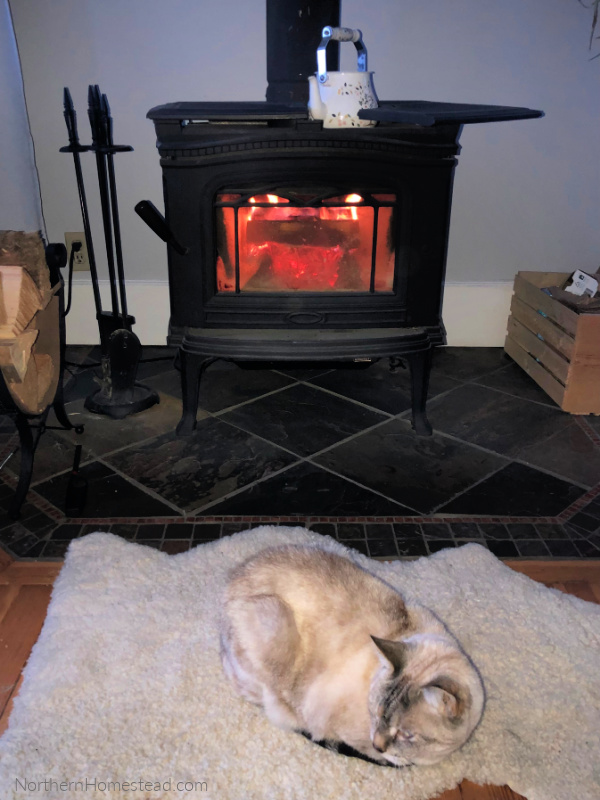
As you know, we are an urban homestead in a small town in Alberta, Canada. It gets pretty cold here in the winter, and having heat is essential. Homesteaders in rural areas often rely on wood for heating, which makes sense if you have ample space for growing and storing it. But what about an urban homestead? Today, let’s explore the topic of heating your home with a wood stove in town.
One feature I wanted in my urban home was a wood-burning stove. Thankfully, ours came with one, and it was a significant selling point for me. Regardless of the weather or the reliability of power and gas, we can stay warm in our house.
Over the last ten years, we have learned much about heating with a wood-burning stove in an urban setting. Here are our most significant tips.
Choose an Efficient Wood-Burning Stove

Heating with wood begins with selecting a wood stove. While traditional wood stoves, as we know and appreciate them, are not the most efficient option, they are commonly used and readily accessible. They are easy to install and effectively do the job, making them a great choice for an urban home.
If you shop for one, get a wood-burning stove approved by your insurance company. It’s important to choose an airtight stove that is appropriately sized for your space. An open fire might be romantic, but in a cold climate, it takes more heat out of the house than it adds in. For insurance reasons, it’s advisable to have the stove installed by professionals. We have a Pacific Energy stove that performs exceptionally well.
A stove in an urban house can be installed either on the main floor or in the basement. It is essential to have a warm basement, especially if you spend family time there, making it a good location for a wood-burning stove. We heat the basement separately and have the wood stove on the main level to use when we’re around. Remember that a wood-burning stove only produces heat when burning, so placing it in an area where you spend time is a wise choice.
Tools needed for a wood-burning stove

Once the wood stove is in place, there are a few indispensable tools and others that we think are optional.
A must-have is a good fireplace tool set with a brush, poker, and shovel. An ash bucket is nice, but in our opinion, any bucket does the same job. If using a plastic pail, you are forced to wait until the ashes are completely cold; this is actually a plus. We would recommend a log holder that can also be used to bring in firewood.
Being in town, we get lots of news and advertisement papers. We use those to kindle the fire. Having a basket to hold the newspapers is handy.
A stove fan is a must. It circulates the heat from the stove into the room. Our wood stove at home has one built into the stove. But most stoves do not. If we could choose again, we would get a stove without the built-in fan; there is no need to use electricity. The heat-powered stove fans work great without any electricity or additional noise.

A wood-burning stove does dry out the air, which is a huge benefit in a humid room. However, in our arid climate, a container with water on the stove is often not enough to humidify the house. So, we recently added a Homvana Smart Humidifier to our setup. We mostly run it on a low setting, which uses very little energy and makes a big difference in our indoor air quality.
Getting firewood

Firewood is the fuel of the wood-burning stove. In an urban setting, there is no firewood available to burn, or is there? We have found that there are many sources of firewood.
A local arborist is a good place to start. They often have firewood already split and ready if they also make money with it. Ask around, for some the work with firewood is not profitable enough, so you might be able to get free wood rounds from an old local tree. Don’t expect the best quality, and you will have to have room somewhere, maybe along a fence to store that wood so it can dry out.

In Alberta, you can also get firewood from the forest for free. But that involves felling the tree, cutting it up to size, and bringing it home. More info about the Personal Use Forest Products Permit (PUFPP) is here.
Firewood companies are often located all around urban settings. If you have the space and manpower to split the wood, it can save you money. Otherwise, split wood might not save you much money on the energy bill. But wood-burning stove heat is much superior to forced air heat during really cold winter nights. In our opinion, it is still worth it.

If space is really limited, as it often is in an urban setting, we have had great experiences with getting the wood after the outdoor space is no longer needed. Now, the deck or driveway can become a wood storage space. The notion that next season’s wood has to be ready in spring is only true if you have space and are getting fresh wood that needs to dry. Buying high-quality dry wood in late fall can be a great option for an urban setting.

Here’s a tip for splitting wood: Mount an old tire on a log and split the wood in it. The wood will stay in the tire and not need a big circle around it, and less bending will be needed.
We like white tarps for the cover. They blend well with the snow in the winter, making them part of the landscape.
How to Start a Fire in a Wood Stove

Kindling a fire in a wood stove is an art that requires practice. Here is a simple method that doesn’t require kindling wood. Start by selecting some smaller logs. We essentially build a small log shelter, using crumpled or twisted newspapers as the ignition source. Place two logs to form the base and two on top, creating a small structure with the newspapers in the middle. You can add another layer of wood. Note that it is essential that the structure has airflow.
Next, open the air inlet entirely and light the newspapers. Lean on the door until you see that the logs have caught fire. Once they burn well, close the door and adjust the air intake to high. Depending on the size of the logs, you may be able to fit an additional log where the newspapers have burned away.

Cleaning the wood stove
We prefer to burn our stove at a high temperature and, if necessary, let it cool down and start a new fire instead of burning it on low for hours. This approach helps prevent creosote buildup in the chimney and reduces maintenance.
Cleaning out the ashes is often overrated. When the stove burns hot, most of the wood is consumed, leaving behind fewer ashes. A stove tends to burn better with some ashes remaining in it. Always ensure the stove is completely cold before cleaning out the ashes to avoid the risk of a fire in the pail or bin. While ashes can be composted for the garden, we do not do this because our soil is already alkaline.
What about Wood burning pollution in an urban area?
Recently, there has been growing concern about pollution, particularly in densely populated areas. Wood burning for heating and cooking is a significant contributor to this issue. Densely populated areas can experience higher levels of smoke and air pollutants, which can reduce air quality.
Addressing these concerns is important. We would not recommend heating with wood 24/7 in an urban setting. We also do not usually cook on a wood stove, as it requires a lot more heat than just heating a room.
Some towns may be too densely populated for wood-burning stoves. However, this is not the case in our current location. If you are uncertain, consult with your development office.
We hope you are staying warm this winter, regardless of whether you have a wood-burning stove. If you’ve been considering installing one, we highly recommend adding it to your home.
We invite you to subscribe to Northern Homestead and follow us on Instagram, Facebook, or Pinterest for the latest updates.
More Blog posts you might enjoy

5 Kitchen Tools to Save Money on Food

DIY and Low-Cost Windows and Doors Insulation Options

Why We Would Recommend a KoMo Fidibus Grain Mill

Do food growers need nutritional supplements?

5 Ways to Preserve Vegetables, Fruits, and Herbs

Heating your Home with a Wood Stove in Town

Simple Winter Compost Solution

40 Easy Tips for Gardening on a Budget

A Country Garden Cabin



Hi, I found that it’s easy to humidify the house with a large tea kettle of water placed on the stove. Keeping an eye on the kettle and not letting it go dry is important, but saves money vs. using an electric humidifier. I’ll have to look into a stove fan. Thank you for the suggestions.
Thank you for your comment. We have used a tea kettle, and it works great for us if we do not heat with wood exclusively. But in our arid, cold climate, it was not enough. Having the option to add more humidity when needed has proven very helpful.